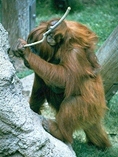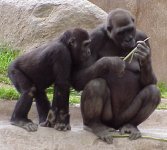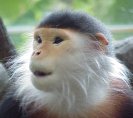 |
|
|
Orangutan mother |
Most primates
do not shape their environment in an adaptive way. They use it as it is
without modification. The sleeping nests of the great apes are poor,
roofless constructions created for only one night. Monkeys simply sleep on
convenient tree branches without making nests. No primate other than humans is
known to store food. They have a hand-to-mouth economy which forces
everyone to seek food and water daily. However, adult male chimpanzees
and adult bonobos of both genders cooperate with others in their community in hunting monkeys and other small game. While
they do not store the meat, they do use it for social gain by sharing it. Jane Goodall has observed
a chimpanzee carry
a carcass as far as a mile over grasslands to reach the safety of trees before
eating it.
Tool manufacture and use are virtually non-existent among non-human primates. However, gorillas, common chimpanzees, bonobos, orangutans, and capuchin monkeys are notable exceptions. Some of them use very simple tools to help in acquiring food and water. For instance, chimpanzees have been observed stripping the leaves from twigs to make probes to get termites and ants to eat. They use similar modified sticks to obtain honey from beehives in tree trunks and from up to a meter underground in subterranean hives. Twigs are also used by them at times as toothpicks. Crinkled leaves are employed as sponges to get water from hollows in trees for drinking. Rocks and broken tree branches are used to crack nuts and sometimes to throw at other chimpanzees in order to intimidate them. Rocks are used at times as projectiles in hunting bush pigs and other small game. However, chimpanzee coordination in throwing is very poor, so rocks and pieces of wood are inefficient weapons for them. Their easy excitability also prevents them from being stealthy hunters. It is important to keep in mind that all of these very simple tool uses by chimpanzees must be taught to children by their parents and other adults. They are not genetically inherited patterns of behavior. As a result, different communities invent different tools. It would not be surprising to discover other examples of simple tool use by non-human primates as more species are carefully observed for long periods of time.
Apes With Tools--simple tool inventions by wild gorillas and chimpanzees
This link takes you to an external website. To return here, you must click
the "back" button on your browser program. (length = 4 min. 42 secs.)Common Chimpanzees Using Tools to Get Honey--pounding bee hives in
trees to extract honey. This link takes you to an external website. To
return here, you must click the "back" button on your browser program.
(length = 2 min. 11 secs.)
 |
|
|
A juvenile
gorilla learning from |
An important advantage that primates have in the competition for survival is their practice of living in societies which have a constant close association of young and old through a long life duration. The young learn survival skills from experienced, knowledgeable adults. The result is that by the time primates are grown, they are usually proficient in dealing with each other and the environment. While primate instinctive survival skills are minimal, their social skills are unusually effective. Acting together in groups, they often can avoid or intimidate predators. Groups of primates also have a greater opportunity in discovering and controlling food sources. The rare species in which most individuals live solitary lives are, of course, exceptions.
The majority of primate species are primarily or exclusively vegetarian. Non-human primate groups usually search for plant foods in a dispersed pattern within their territory. This increases the likelihood that food sources will not be missed. Foraging in tightly spaced groups is successful only if the food appears in concentrated clusters. With the exception of some chimpanzees, most primates do not use calls to inform others when they find food. The message spreads slowly and reaches the entire group only if the food is abundant. Non-human primates are generally stingy, except when dealing with young infants. Feeding monkeys usually tolerate others only beyond a certain distance. When monkeys observe another member of the troop stuffing food into his or her mouth, they usually rush over to get some as well. Inadvertently, the monkey who discovers a desirable food source communicates its presence by his or her actions. In this way, information about food sources is shared. This is especially true of semi-terrestrial species such as baboons and macaques.
Once again, chimpanzees are exceptions. Males regularly hunt for meat in small teams. When a target animal has been killed, the dominant hunter initially monopolizes the meat. However, when he has had enough to eat, he usually shares with other hunters and even with females and children who have not participated in the hunt. More easily obtainable vegetable foods are rarely shared by chimpanzees except by mothers with their children. Mothers use this opportunity to teach their children what is edible in the environment. They also teach them important skills such as nut cracking techniques.
Among chimpanzees and baboons, the size and composition of the foraging group normally adjusts to the size of the food supply. Strictly arboreal monkeys are not equally flexible--the entire community makes up a single foraging group. This is related to the fact that their forest territories are usually smaller and richer in vegetable foods.
Why are Primates
Intelligent?
 |
|
|
Does
this douc langur |
Compared to most other animals, primates have unusually large brain to body size ratios and are significantly more intelligent. This is particularly true of the great apes and, of course, humans. When chimpanzees look in a mirror, they recognize themselves. This self-awareness is extremely rare in the animal kingdom. Even monkeys lack this capability. It was commonly believed that only humans had the necessary intelligence to recognize their own reflected image. The fact that we share self-awareness with at least some of the great apes is not surprising considering the short evolutionary distance between our species. We had a common ancestor with chimpanzees only 6-7 million years ago.
In the past, biological anthropologists believed that the relatively high intelligence of the great apes and humans was a result of natural selection favoring tool making. However, it is now clear that ape tool use is relatively modest compared to humans and even some insects. Bee hives and termite mounds are certainly more complex structures than anything apes create.
It has been suggested by some researchers that the large ape brain was mainly selected by nature for dealing with complex social interaction and only secondarily for tool making and manipulating objects in their environment. The connection between social skills and intelligence can be seen operating in chimpanzee societies. Success for an individual usually requires that he or she has the ability to learn from others, invent new behaviors, comprehend the status and complex emotions of all other troop members, and can use this knowledge to gain advantages. Chimpanzees learn how to influence and even manipulate the emotions of others in their communities. High ranking adult males in particular become skilled at bluff, deception, and intrigue. They are scheming political animals who spend much of their time creating and maintaining alliances with other males. In order to succeed, they need to be "chess masters" of their social worlds. The ability to predict the combined effects of yours and other's actions and to control your own emotions and behavior may be among the most important characteristics that led to the large ape brain. Ultimately, it may have led to the even larger and more intelligent human brain. This idea is supported by recent neurobiological research done by John Allman and his colleagues at the California Institute of Technology. They discovered that there is a particularly large type of spindle-shaped neuron cell in the brain that is apparently unique to apes and humans, and concentrated more in people. These neurons are in areas of the brain known to be involved in complex decision making.
As
we have seen, behavioral patterns of non-human primates are largely
non-instinctive. The great apes in particular rely heavily on their
learned skills and knowledge to survive. In the past, many
anthropologists resisted referring to this as culture. They
preferred to reserve
the term for more complex human knowledge, traditions, and skills.
However, if culture is defined more broadly as learned behavior patterns, then
we must accept that at least some non-human primate communities do have
cultural knowledge that they pass on to their children informally much the same way
humans do. Basic survival skills are taught to children mostly by
mothers and other adult females within all primate species, including our
own. Some anthropologists have suggested that since
the cultural knowledge of non-human primates is, at best, quite rudimentary,
it is appropriate to call it protocultural
![]() . That
is to say, they have the beginnings of culture.
. That
is to say, they have the beginnings of culture.
Ape Genius--great ape ability to cooperate and learn new behavior compared to humans
This link takes you to an external website. To return here, you must click the "back"
button on your browser program. (length = 49 min. 29 secs. in 6 parts)
Evolutionary
Significance of
the Primate World Distribution
One sign of a biologically successful species is the size of its geographic range and the number of different environmental zones it inhabits. Those species that are only able to adapt to very limited ranges are relatively less successful. Based on this criterion, common chimpanzees are the most successful ape and macaques are the most successful monkey. Since the human range includes all of the other primate ranges plus a massive expansion into colder regions and onto isolated oceanic islands, we are the most successful primate. What has allowed us to do this has been our significantly greater intelligence and the development of our complex cultural survival technologies. In a sense, human culture has allowed us to live in various harsh environments without adaptively radiating into different species. We became different kinds of cultural animals rather than different biological species as we adapted to new environments.
NEWS: In a May 15, 2007 Current Biology report, Simon Townsend et.al., described a violent attack by 6 female wild chimps on a female from another community that resulted in serious wounds for her and the death of her infant. They also referred to two other similar attacks that have been observed recently. This is surprising news since normal female primates were not known to instigate such murderous attacks and infanticide. It is more commonly a male behavior.
NEWS: In an April 8, 2008 PLoS One report, Christina Gomes and Christophe Boesch of the Max Planck Institute for Evolutionary Anthropology in Germany presented evidence of wild chimpanzee males in West Africa regularly sharing meat with females in exchange for sex at a later time. These long-term exchange arrangements result in more calories in the diet of females and more opportunities for males to mate.